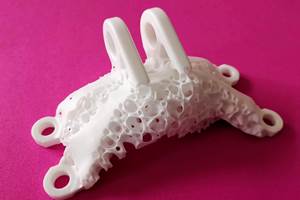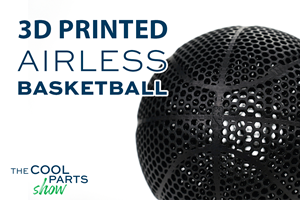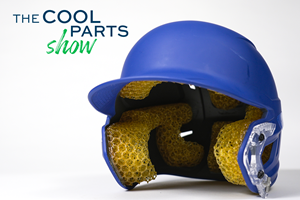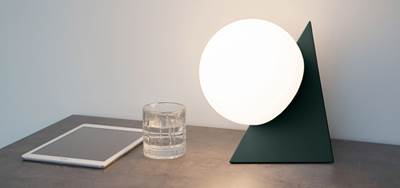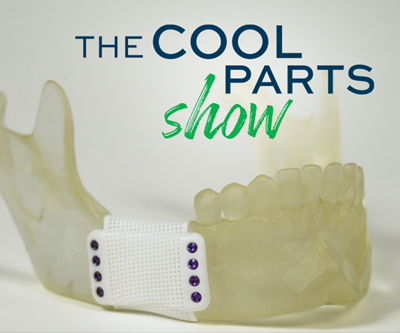3D Printed Ceramic Mug: The Cool Parts Show #48
MadeXBinary applies additive manufacturing to clay. The company achieves automated production of aesthetically pleasing kitchenware through digital pottery.
Share
We tend to see pottery as a manual process — the work of an artist's manual skill, perhaps working at a potter’s wheel. Matt Sutton, through his company MadeXBinary, applies an entirely different form of art and skill to produce pottery. Mastering 3D printing with clay has enabled him to realize fully automated production of distinctive, aesthetic kitchenware forms, including the 3D printed mugs we look at in this episode of The Cool Parts Show. Clay is a type of ceramic material that is in some ways easy to 3D print, and in other ways challenging to apply this way. We talk about the challenges. Succeeding at additive manufacturing in clay has allowed MadeXBinary to develop what Sutton calls "digital pottery."| This episode of The Cool Parts Show brought to you by Carpenter Additive
The Cool Parts Show is a video series from Additive Manufacturing Media that explores the what, how and why of unusual 3D printed parts. Watch more here.
Have a cool part to share? Email us.
Related Resources
- MadeXBinary
- More 3D printed ceramics: bioceramics for bone replacement
- More 3D printed ceramics: automotive piston
Transcript
Peter Zelinski
Making a mug with additive manufacturing. How do you 3D print with clay? Digital pottery, on this episode of The Cool Parts Show.
Stephanie Hendrixson
This episode of The Cool Parts Show is brought to you by Carpenter Additive.
Peter Zelinski
We're at the company's powder production facility in Athens, Alabama.
Stephanie Hendrixson
Specifically, we are standing on top of the Z1, the company's largest vacuum atomizer for producing metal powders.
Peter Zelinski
Want to know how to make metal powder for additive manufacturing? Stick around after the episode.
Peter Zelinski
I'm Pete.
Stephanie Hendrixson
I'm Stephanie.
Peter Zelinski
Welcome to The Cool Parts Show.
Stephanie Hendrixson
This is our show all about cool, unique, interesting 3D printed parts and, Pete, I can't help but feel the studio looks a little bit different. You seem to have replaced your Additive Manufacturing Media mug with something else.
Peter Zelinski
We're going to talk about this "something else". We are going to talk about this mug. We're going to talk about digital pottery.
Stephanie Hendrixson
I love it already. Tell me more.
Peter Zelinski
3D printing with clay, 3D printing to make mugs, among other things. I've got another one right here. And actually, yeah, I am kind of troubled by the unbalance now. So let me let me fix this.
Stephanie Hendrixson
All right, so, digital pottery, mugs, you have my attention. I am a person who collects lots of mugs. I have, I don't know how many, but even like some handcrafted mugs. And I don't have anything that looks quite like this.
Like the handle is kind of unique and you can sort of see the lines. I can kind of visualize how this might have been 3D printed. But first things first. Where do these come from? Who made them?
Peter Zelinski
Right. I love that you said handcrafted because you think about pottery and that's what you imagine. You imagine a potter's wheel and manually sculpting the form. And in many ways, this is the opposite of that. This is almost fully automated pottery making using 3D printing, 3D printing of clay. Who made it?
This is the work of a small startup in Utah called MadeXBinary. And really it's the work of one person, one engineer who has put a lot of thought into how to 3D print with clay. His name is Matt Sutton.
I'd like you to meet him.
Matt Sutton
So the way I got started with 3D printing of ceramics was actually quite accidental. I had been looking at ways of using robotic arms to print large format objects out of recycled plastics. And there was this interim time where I had this robot arm to use, but I didn't have an extruder for plastic.
And so I needed some sort of stand-in that allowed me to test out things like tool path strategies, etc. And I started doing some research around other materials that were maybe easier to deposit and stumbled into this world of clay 3D printing.
And so over the course of basically a weekend, I constructed just a very simple extruder, which was basically a large pipe that took compressed air in one side and squished clay out the other. But I think the process of going through that and then just seeing that output and understanding that now you had the ability to once that object had dried, to fire that and have this very durable, kind of long lasting object, was pretty transformative for me and really ignited sort of a curiosity around what else could you do with this material using this additive technique?
Stephanie Hendrixson
All right. So this is interesting. Like at the beginning of this episode, I kind of had the inkling that we might be talking about clay, we would be talking about ceramics in some regard. But it's funny that that wasn't the problem Matt was originally trying to solve. Like he was trying to figure out how to extrude polymer and clay was just this accessible, affordable material to experiment with. But clearly he's kind of figured that out. He's probably learned some things. Can we just talk about the clay for a minute and 3D printing with clay?
Peter Zelinski
I would love to. He is 3D printing with clay. And on the one hand, that's an easy material to 3D print with it's soft, it extrudes easily. On the other hand, it is a difficult material to 3D print with. It stays soft a long time. You have to really think about gravity. There's a lot more going on than the 3D printing. I think we'll talk about that. But it starts with the 3D printing and there's a lot of thought and care that goes into getting an aesthetic, elegant form like this. So let's let Matt talk more about 3D printing with clay.
Matt Sutton
So with clay 3D printing, it introduces a number of challenges that are not present with 3D printing, other materials, namely plastics. And I like to say that it's like 3D printing with plastic, but just harder. So you already have this technology that's very vertically biased, that can really only tolerate a certain amount of overhang, for example. Any kind of horizontal structures tend to need to be supported. And the same is true with clay, although instead of a material that freezes fairly quickly, like plastics do, it's a material that comes out of the nozzle with a consistency closer to like a thick peanut butter and then takes several hours to dry and solidify. So your geometries really need to consider gravity much more than you might with something like plastic. And that factors into the material composition as well. So I tend to work with standard potters clays, bagged clays that you might find at any kind of pottery supply store, but needing to add some water to help with the flow of that material through the system and out of that nozzle. So you're taking a material that already sort of has these inherent qualities that make it hard to build certain geometries and then making that even harder with the addition of water. So you're constantly needing to maintain a suitable mixture that allows for good flow through the nozzle on one hand, but that isn't so watery that your part collapses on the other. So it's quite a fine line to walk sometimes.
Peter Zelinski
He said vertically biased. Can we talk about that? Can we pause to appreciate the design for additive manufacturing of this form? So a reality of additive manufacturing, a challenge, particularly with deposition-style 3D printing, is where there are structural overhang forms, features that present overhangs, you frequently need support structures to support them during the build process. Support structures can't work here. That would compromise the aesthetics, the look of this, the style. No support structures. So how do you 3D print a mug?
A mug has in the handle this unsupported section so you have to reconceive the handle of a mug for 3D printing. Here is the mug redesigned re-engineered for a deposition style 3D printing process.
Stephanie Hendrixson
Yeah. So the vertical bias, Matt took what is basically a weakness of the 3D printing process and he kind of turned it into like a really cool solution. So this handle has no overhang, it has no horizontal surface in the same way that these do. And it's just got like this cool indent where you can pick it up and hold it and it's functional as a handle. So you mentioned that the 3D printing is not the whole story and I am understanding the clay comes out of the printer, it's soft, it's pliable. How do we go from that to something that is hard and durable and functional as an actual mug?
Peter Zelinski
3D printing for an object like this takes about seven or 8 minutes. It has to dry. It dries for anywhere from like 12 to 24 hours. It's pretty hard at that point. There is a bisque firing process in a kiln, after that comes glazing and then it's ready for a second firing back to the kiln.
Stephanie Hendrixson
So okay, stop right there because we talk all the time about how 3D printing is just one part of the additive manufacturing process or workflow. Like there's design work, there's set up that has to happen beforehand. And then there's usually various post-processing steps that happen afterwards. But the ratio here like seven or 8 minutes for the printing followed by like basically days to get through the drying and the firing and the glazing. Like that's just a crazy ratio.
Peter Zelinski
It is funny when you say it like that. We talk all the time about how additive manufacturing it's more than 3D printing, and in this case it's way more, at least in terms of the time stamp. The percentage of time that is the actual 3D printing is minute. But the amount of thinking and engineering and bandwidth, it's all concentrated in that 3D printing step. This is digital pottery. The digital does the pottery. And so to get like a form like this that's graceful and beautiful like this, it involves getting that 3D printing just right.
Matt Sutton
So the coffee mugs that I make are particularly challenging for a number of reasons. Some of the ways that I could overcome those challenges really were through tightly controlling the tool path and then the extrusion that's coming out of that nozzle. So one of the challenges initially was how can you create an object with this bottom that is attractive both from the inside and also the outside on the bottom here, and then maintains this very nice, smooth, rounded transition up to the vertical wall. And then the second challenge was how to complete the print without leaving any sort of indication of where that print finished and also maintaining this nice kind of helix tool path that's used to to create this. And so the ways that some of those problems are resolved is through kind of a custom layer height that's accomplished by basically taking a path along this wall and segmenting that to determine our layer heights, if you will, and then a tapering off of the extrusion at the top that gives you this nice kind of tapered finish that leaves very little, if any mark as the nozzle leaves the part.
Stephanie Hendrixson
So it's neat to hear Matt talk about the design challenges and the tool path challenges with this mug, because as you look at it like you can actually see evidence of it. So you can see like the helical pattern on the bottom. You can see how he made that that transition up the wall. Looking at the lip, you cannot tell where that layer ends. So it's clear, like you said, that a lot of care, a lot of thought went into this product. Does he make anything other than mugs?
Peter Zelinski
Yeah, it's mostly drinkware. It's mugs. It's tumblers, it's oil cruets. You are the chef among us, cruet is a new word for me. Salt and pepper shakers. He makes salt and pepper shakers. And that is a form where there's actually, there's a roof on an object like that, you know, the lid of the shaker. But the adhesion of the clay is just enough that he found he was able to 3D print the way across that form.
Stephanie Hendrixson
So that's cool. Like just by virtue of the material he's found there are some situations where you can do that horizontal surface and bridge a gap like that. So the other thing I think is really neat about this is that looking at it, you can kind of tell it was 3D printed at least if you sort of know what you're looking at. And what I mean is that Matt has made the decision to leave the layer lines.
These come off of the printer, they're soft, I imagine it wouldn't be that hard to smooth out the surface if you wanted to. But instead, he's left those tool paths, basically. You can see the digital pottery. It's front and center.
Matt Sutton
So one of the features of these mugs that I'm most proud of is the fact that there's really no hiding that it's a 3D printed object. I felt pretty strongly as I started making ceramics this way that it was important that there be an honesty about how these objects are created. And so not only is the exterior of the cup maintaining this layer aesthetic, but the use of a clear glaze on the inside also allows the user to clearly see these layer lines. And I feel like that's a feature of the part, not necessarily something, you know, to necessarily hide.
Stephanie Hendrixson
All right. I think I got this.
Peter Zelinski
You go.
Stephanie Hendrixson
All right. These are 3D printed mugs from MadeXBinary. It's a startup in Utah, actually just one guy, Matt Sutton. And Matt was working on developing an extrusion polymer printer. He was experimenting with clay to kind of figure out the tool paths and got interested in this way of making durable ceramics with 3D printed clay. In the case of these particular mugs, they're 3D printed in a process that takes just seven or 8 minutes, after which they go through a long period of drying, various kiln firings and glazing to arrive at this finished product. And these are an example of digital pottery. Pottery is this thing that we think of as being very hands on, kind of low tech. And this is a very high tech, low touch, automated way of getting to ceramics like this.
Peter Zelinski
Thank you to Matt Sutton for reaching out to us in the first place for telling us about this work 3D printing of clay. If you are working on something special, distinctive with 3D printing and you think not enough people know about it, we want to know about it.
Email us: CoolParts@AdditiveManufacturing.media.
Stephanie Hendrixson
If you like this episode, give us a like. Leave us a comment. If you have any questions, let us know and make sure to subscribe on YouTube so you get notified about all of our new episodes.
Peter Zelinski
Thank you for watching.
Peter Zelinski
This episode's brought to you by Carpenter Additive, we are at the company's powder production facility in Athens, Alabama, and we are standing on top of an atomizer. The Z1 is Carpenter Technology’s largest vacuum atomizer, and it is the heart of the process for making additive manufacturing metal powder here at Carpenter Additive.
Stephanie Hendrixson
This facility is capable of producing up to 18,000 pounds of metal powder per day. Plant Manager Jordan Ralph talked us through the process.
Jordan Ralph
So an atomizer is a piece of equipment that is capable of melting and pouring molten metal into the stream of high pressure gas that turns that molten metal into tiny tiny droplets that ultimately cool and form our powder, which looks like grey dust. So to start our process, and the ultimate end to end solution that we have here, we bring in raw materials, all the way down to individual elements. So nickel, cobalt, chrome, moly, niobium, we bring all of those raw materials into the shop, we utilize those materials to build charges that go into the atomizer. As you walk that flow path, you run through our charge makeup area where all of the materials are weighed out in very exact quantities, and that ensures that we're able to hit our customer specifications and hold the tight tolerances that we're looking for on a chemistry perspective. From there, the material is flown to the top of the atomizer and charged into the furnace. As the material is produced it's poured out and is collected at the bottom of the atomizer. The material is then taken and transferred into a bolt container for processing through the rest of the value stream. The next stop for any of our as atomized powder would be the screener. So that will remove the coarse portion of the powder. From there, we take it through air classification, that takes the fine portion of the particle size distribution out and makes the final cut for an additive material like a 10 to 45. From there, we stacked up all of those individual lots and put them into the 12,000 pound blender to make the single homogenous blends. At that point, we are able to pack in any configuration that the customer is looking for, whether that be drums, bottles, PowderTrace Hoppers, we've got a lot of options to meet the customer's needs. The optimization capability and all of the powder capabilities gives us a unique position where we're actually able to produce the powder, run testing through additive machines all the way through HIP and heat treat, do final testing on those products and then make additional changes or try to optimize you know things like our chemistry or sizing so that we ultimately can serve our customers better.
Related Content
Spherene Creates Metamaterial with Geometry Derived from Spheres
An algorithm developed by Spherene Inc. generates Adaptive Density Minimal Surfaces (ADMS) as a self-supporting infill strategy that can be used to reduce mass and manage material properties in 3D printed parts.
Read MoreBike Manufacturer Uses Additive Manufacturing to Create Lighter, More Complex, Customized Parts
Titanium bike frame manufacturer Hanglun Technology mixes precision casting with 3D printing to create bikes that offer increased speed and reduced turbulence during long-distance rides, offering a smoother, faster and more efficient cycling experience.
Read MoreAirless Basketball Shows Promise of 3D Printed Lattices: The Cool Parts Show Bonus
Successfully matching the performance of a standard basketball demonstrates the control possible over the mechanical properties of digital materials.
Read More3D Printed Lattices Replace Foam for Customized Helmet Padding: The Cool Parts Show #62
“Digital materials” resulting from engineered flexible polymer structures made through additive manufacturing are tunable to the application and can be tailored to the head of the wearer.
Read MoreRead Next
Angled Makes It Possible for Anyone to Launch a 3D Printed Product
The online store utilizes open capacity at its sister 3D printer farms for on-demand production with no startup costs, allowing designers to sell physical products as easily as digital ones.
Read MoreGantri’s 3D Printed Luxury Lighting Brings Designers Closer to Consumers
The San Francisco startup is changing designer lighting with a designer-forward online marketplace and just-in-time delivery enabled by 3D printing.
Read MoreBioceramics for Bone Replacement: The Cool Parts Show #18
A mandibular cage made up of two different bioresorbable ceramics points to the future of bone graft and reconstructive surgeries in this episode of The Cool Parts Show.
Read More








